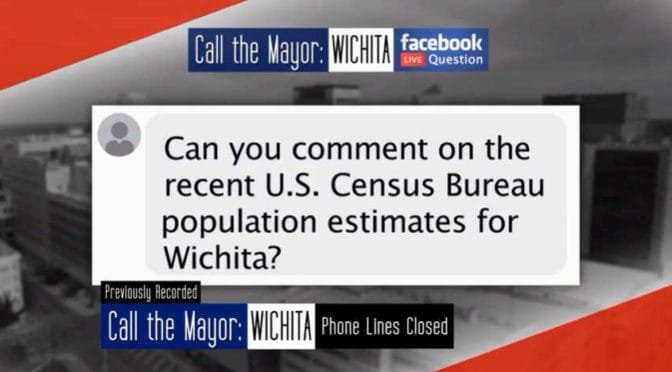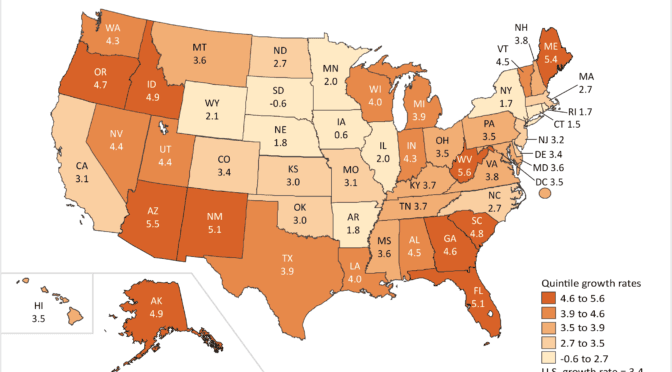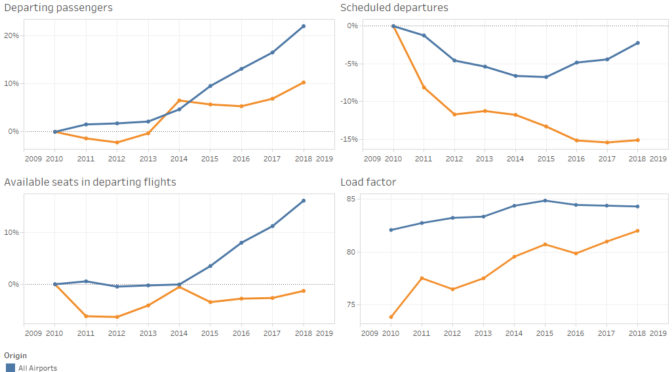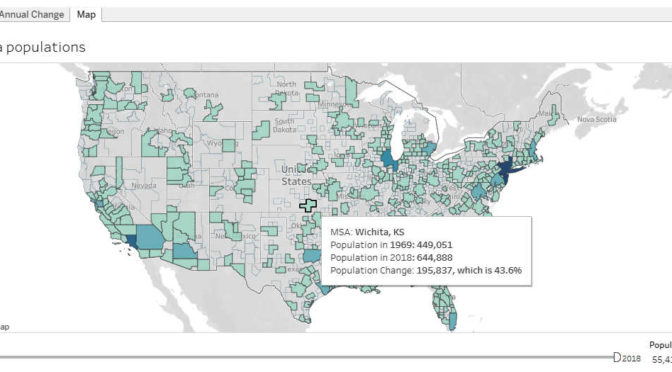It is unfortunate that Wichita city and metro populations are falling. It is unimaginable that our city’s top leader is not aware of the latest population trends.
In May, Wichita Mayor Jeff Longwell told viewers of the KPTS Television program Call the Mayor that he was not aware of the latest United States Census Bureau estimates of population for Wichita. (A transcript of this portion of the program is below.)
Mayor Longwell said he wasn’t aware of the estimate, telling the audience, “census estimates are different than the census.” Absolutely correct. The census, which is an attempt to count the population, happens only once every ten years, while census estimates for population are produced annually. With only decennial data, we wouldn’t know much about recent developments.
Estimates are important. We use them in numerous circumstances when producing a count would be expensive. Mayor Longwell said he hasn’t seen estimates for population, but he knows the unemployment rate for Wichita. That is also an estimate produced by a different branch of the federal government. The city uses many estimates. The “City Overview” section of the budget document starts with: “Wichita, the largest city in Kansas with a population 389,965 …” The footnote gives the source of the data as “2015 Census population estimates.”
On Call the Mayor, Longwell said, “our population in Wichita has grown from 2000 by nearly 40,000 people.” Interestingly, if the mayor doesn’t want to use estimates, he should have said the City of Wichita population grew by about 30,000, as that is the difference between the 2010 and 2000 census counts. Based on the estimate of city population for 2018, growth has been almost 37,000.

Wichita’s unemployment rate is low, and has been declining
One of the reasons the Wichita unemployment rate is low is because of a declining labor force. As can be seen in the nearby chart, the unemployment rate (green line) has fallen — and by a lot — since the end of the last recession in 2009. (Click here for an interactive version of the chart.) But the unemployment rate depends on two things, one being the labor force as the denominator of a fraction, or ratio. If the denominator (labor force) falls at a greater rate than the numerator, the unemployment rate will fall. That is what has happened in Wichita.

For example, on January 1, 2010, the labor force in Wichita was 320,287 and the number of unemployed persons was 28,523, resulting in an unemployment rate of 8.9 percent. The number of employed persons was 291,764.
Then, on April 1, 2019, the labor force in Wichita was 311,114 (falling by 9,173 or 2.9 percent) and the number of unemployed persons was 11,576 (falling by 16,947 or 59.4 percent), resulting in an unemployment rate of 3.7 percent. The number of employed persons was 299,538 (rising by 7,774 or 2.7 percent).
If, for example, the current labor force was the same size as on January 1, 2010, and we have the same number of employed people as we do today, there would be 20,749 unemployed people, and the unemployment rate would be 6.5 percent instead of 3.7 percent. (We don’t know what would have happened had the labor force not fallen, but this is an example of how the arithmetic works.)
This is unfortunate
It is unfortunate that the city and metro populations are falling. It is unimaginable that our city’s top leader is not aware of the latest population trends. These numbers are easy to find. Until recently, they would be reported in local news media.
But the city has an economic development staff that ought to be aware of these numbers. There is the Greater Wichita Partnership, responsible for shepherding economic development. There is a city manager, assistant city manager, six city council members, and a fleet of bureaucrats. Didn’t any of these people know the population has declined? If not, why not?
And if any knew the population was declining and didn’t tell the mayor, well, that’s another problem.
Transcript from Call the Mayor, May 30, 2019
Host: We have a Facebook question from Bob. Could you please comment on the recent US Census Bureau population estimates for the city of Wichita and Wichita metro stat area for the year ending July 1, 2018. It’s very specific but the latest on the census for Wichita.
Longwell: So the census estimates are different than the census and so I’m not I haven’t seen the census estimate data specifically. I know the region … Wichita is becoming a destination for health care and so you’re starting to see many people in rural Kansas migrate to big cities and we’re no different. I know that our population in Wichita has grown from 2000 by nearly 40,000 people and so we will continue to see that growth and right now we need more people. We need people to fill these jobs that are in Wichita. Our unemployment’s at historic low right now.
To view the program on YouTube starting at the point of this question, click here.
—
Notes
- Weeks, Bob. Wichita population, 2018. Available at https://wichitaliberty.org/economics/wichita-city-population-2018/. ↩
- Weeks, Bob. Wichita population falls; outmigration continues. Available at https://wichitaliberty.org/wichita-government/wichita-population-falls-outmigration-continues/. ↩
























